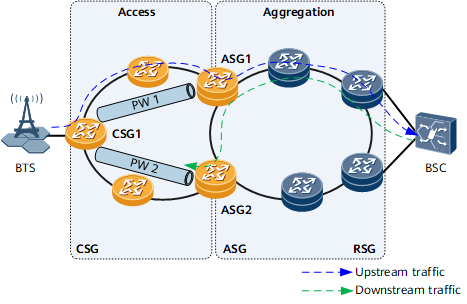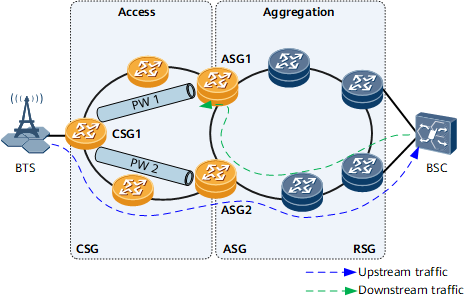ND Dual-Fed in L2VPN Scenarios
During network deployment, a pair of devices are deployed for a service to implement redundancy protection. In this case, two PWs need to be deployed to achieve PW redundancy. However, PW redundancy may cause packet loss in the following scenarios:
As shown in Figure 1, PW1 is the primary PW and PW2 is the secondary PW. When the BTS transmits traffic to the BSC, the BTS first sends NS multicast packets to CSG1. CSG1 forwards the received NS multicast packets to ASG1. Upon receipt of the packets, ASG1 can learn ND entries of the BTS. In this case, ASG2 does not receive NS multicast packets or learn ND entries of the BTS. When the CSG1-to-ASG1 link is faulty, the secondary PW takes over and the BSC-to-BTS traffic is forwarded through ASG2. Because ASG2 does not learn ND entries of the BTS, packet loss occurs.
As shown in Figure 2, the CSG1-to-ASG1 link becomes faulty. In this case, the BTS forwards NS multicast packets to the BSC over the CSG1-to-ASG2 link. Upon receipt of NS multicast packets, ASG2 can learn ND entries of the BTS. In this case, ASG1 does not receive NS multicast packets or learn ND entries of the BTS. When the CSG1-to-ASG1 link recovers, the primary PW takes over and the BSC-to-BTS traffic is forwarded through ASG1. Because ASG1 does not learn ND entries of the BTS, packet loss occurs.
With the ND dual-fed function configured on CSG1, when CSG1 receives NS/NA packets from the BTS, CSG1 caches the packets locally. After a primary/secondary PW switchover is performed, CSG1 sends the cached NS/NA packets to the ASG whose PW status is Active. In this case, the ASG can generate ND entries based on legitimate NS packets or update ND entries based on legitimate NS or NA packets. This prevents downstream traffic from being discarded by the ASG, improving network reliability.

